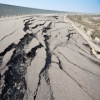AGI policy news briefs summarize geoscience policy activities and related events in Washington, D.C. as part of an effort to keep AGI member societies and other audiences informed about relevant federal policy and legislative updates.
To search for news briefs for a specific Monthly Review digest, enter the year and month of the Monthly Review in the search fields below.
Please note that as of April 2019, the publication of news briefs and the monthly review has been suspended. Policy news from April 2019 back to 2010 is available below; to browse Monthly Reviews from 1996 through 2010, please visit the Monthly Review Archive.
President Donald Trump issued an executive order “Promoting Energy Independence and Economic Growth” on March 28.
Industry and agency experts examined the United States’ increasing dependence on foreign sources of minerals on March 28.
The Pacific Northwest Earthquake Preparedness Act (H.R.654) moved a step closer to becoming law when the bill passed the House on March 27.
The National Academies of Sciences, Engineering, and Medicine held a workshop on long-term approaches for wildfire management on March 27.
Senators Maria Cantwell (D-WA) and Lisa Murkowski (R-AK) introduced the bipartisan National Landslide Preparation Act (S.698) on March 22.
The House Committee on Science, Space, and Technology, Subcommittee on Research and Technology held two oversight hearings on funding priorities for the National Science Foundation (NSF).
President Trump released his fiscal year (FY) 2018 budget blueprint outlining funding priorities and top-line spending levels for federal agencies.
Representative Scott Peters (D-CA-52) introduced the Secure and Resilient Water Systems Act (H.R.1579) on March 16.
On March 15, Senator Bill Cassidy (R-LA) introduced a bill that would authorize more lease sales on the Outer Continental Shelf (OCS).
House Republicans introduced a resolution (H.Res.195) on March 13 that expresses commitment to environmental stewardship.
On March 8, two members of the House Science, Space, and Technology Committee introduced bills addressing scientific research and review practices at the Environmental Protection Agency (EPA).
Soda ash, also known as sodium carbonate, which is used in products such as glass, detergent, and other industrial goods, may receive a royalty cut.
Two bills introduced in the Senate and House would permanently authorize the Land and Water Conservation Fund.
Representative Duncan Hunter (R-CA-50) introduced the "Materials Essential to American Leadership and Security (METALS) Act" (H.R.1407) to ensure the U.S. has access to a sustainable and secure supply of materials to safeguard our national security on March 7.
The Department of the Interior (DOI) will offer 73 million acres, including all available areas in the Gulf of Mexico, for oil and gas exploration and development, according to an announcement from Interior Secretary Ryan Zinke on March 6.
The House passed the Regulatory Integrity Act of 2017 (H.R.1004) on March 2.
A bipartisan group of senators introduced the Nuclear Energy Innovation and Modernization Act (S.512) on March 2.
The House passed the OIRA Insight, Reform, and Accountability Act (H.R.1009) on March 1, 2017.
Congress successfully passed the Outdoor Recreation Jobs and Economic Impact Act of 2016 (H.R.4665).
The International Energy Agency released its 2016 World Energy Outlook on November 18.
The Environmental and Energy Study Institute held a briefing to address the actions China plans to take to achieve its goals under the Paris Climate Agreement.
The White House released its Mid-Century Strategy for Deep Decarbonization, which identifies key actions the United States must take to reduce its carbon footprint by 2050.
The U.S. Geological Survey has announced a new grant program that will award up to $2 million in cooperative agreements for new state and local water resource agencies participating in the National Groundwater Monitoring Network.
On November 10, the National Academy of Sciences hosted a panel discussion on the Cascadia Subduction Zone and its potential for large scale fault rupture.
NASA and the Federal Emergency Management Agency hosted an asteroid emergency planning exercise on October 25 in El Segundo, California.
The Bureau of Ocean Energy Management’s Mid-Atlantic Regional Planning Body submitted its Mid-Atlantic Regional Ocean Action Plan to the National Ocean Council for certification on November 3.
The White House Council on Climate Preparedness and Resilience recently released a report entitled Opportunities to Enhance the Nation’s Resilience to Climate Change.
The National Science Foundation (NSF) and the U.K.-based Natural Environment Research Council (NERC) are partnering to fund $25 million in scientific research to study the Thwaites Glacier in West Antarctica.
The Bureau of Ocean Energy Management (BOEM) recently completed two projects undertaken after Hurricane Sandy.
On October 18, the Senate Committee on Energy and Natural Resources held a hearing at the Hawaiian State Capitol in Honolulu.
The White House hosted the Frontiers Conference this October in Pittsburgh, Pennsylvania.
On October 13, 2016, President Obama released an executive order addressing space weather hazards in the U.S.
The World Energy Council, a United Nations-accredited global energy consortium, released its 2016 World Energy Resources Report on October 12.
The Paris Climate Agreement reached the minimum requirements necessary to enter into force this October, four years earlier than the previously anticipated 2020 target.
Five federal agencies are working to increase consumers’ awareness of the benefits of switching to water- and energy-efficient fixtures and building codes.
On September 15, the Senate passed the Water Resources Development Act (WRDA) (S. 2848), marking a major milestone in the two-year water policy bill. The bill passed with a final vote of 95-3. The House version of the bill was voted upon once an amendment authorizing funding to aid Flint, MI, was approved, and it passed on September 28 with a final vote of 399-25.
The Consortium for Ocean Leadership (COL) held a briefing on the economic impacts of ocean acidification (OA), or the process in which the ocean absorbs CO2 from the atmosphere, making its pH slightly more acidic.
On September 21, 2016, President Obama signed a memorandum addressing national security concerns posed by variations in Earth’s climate.
























